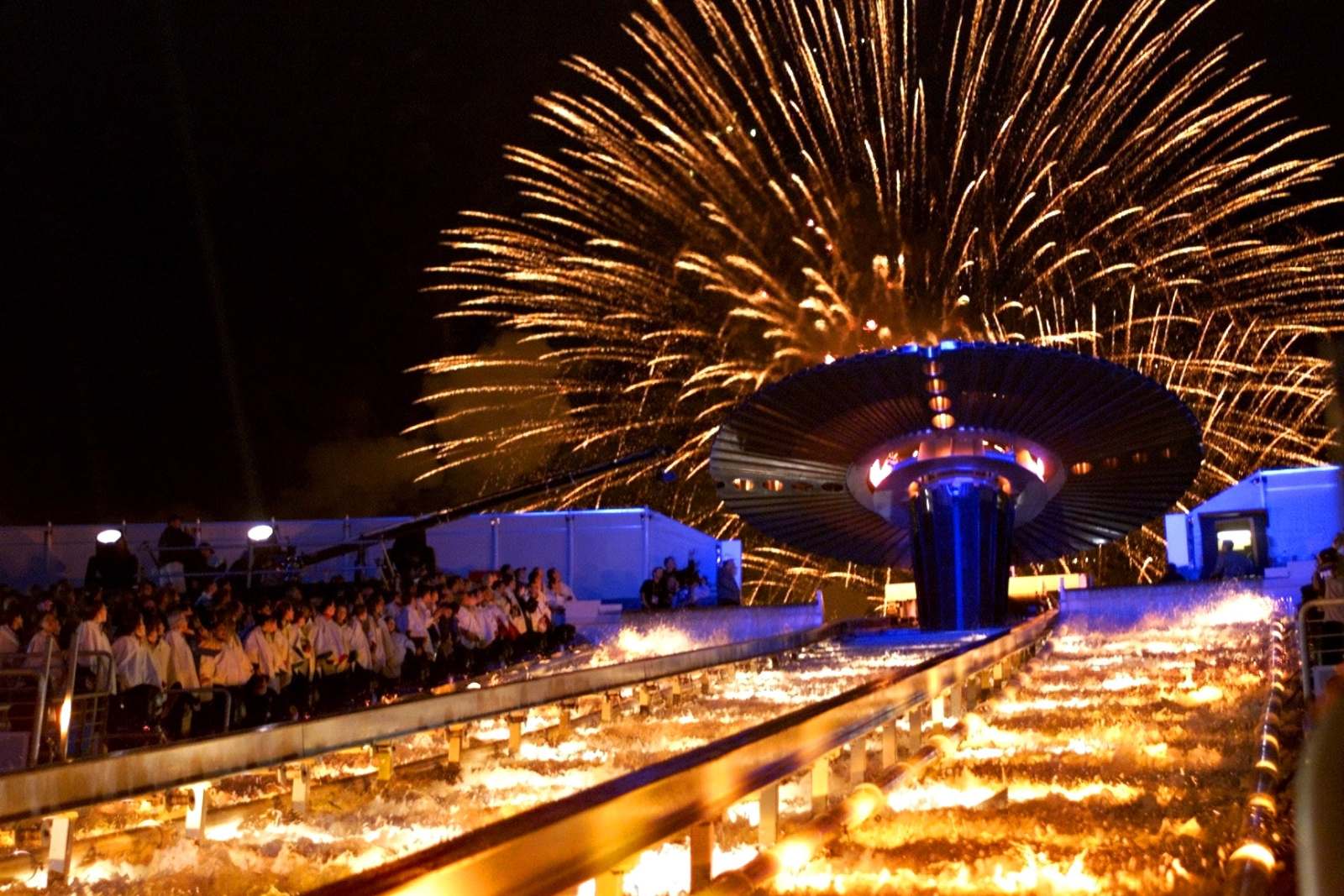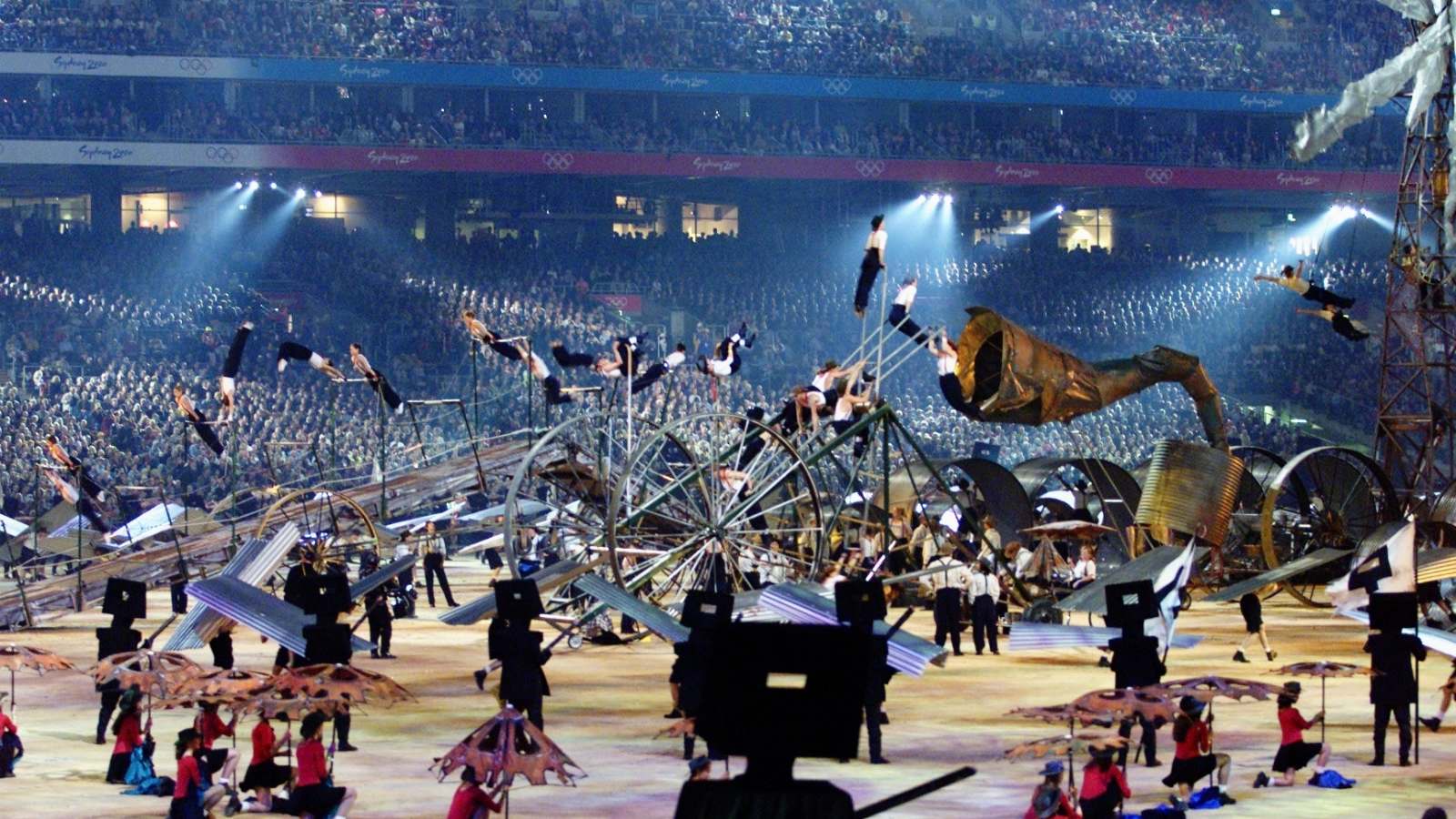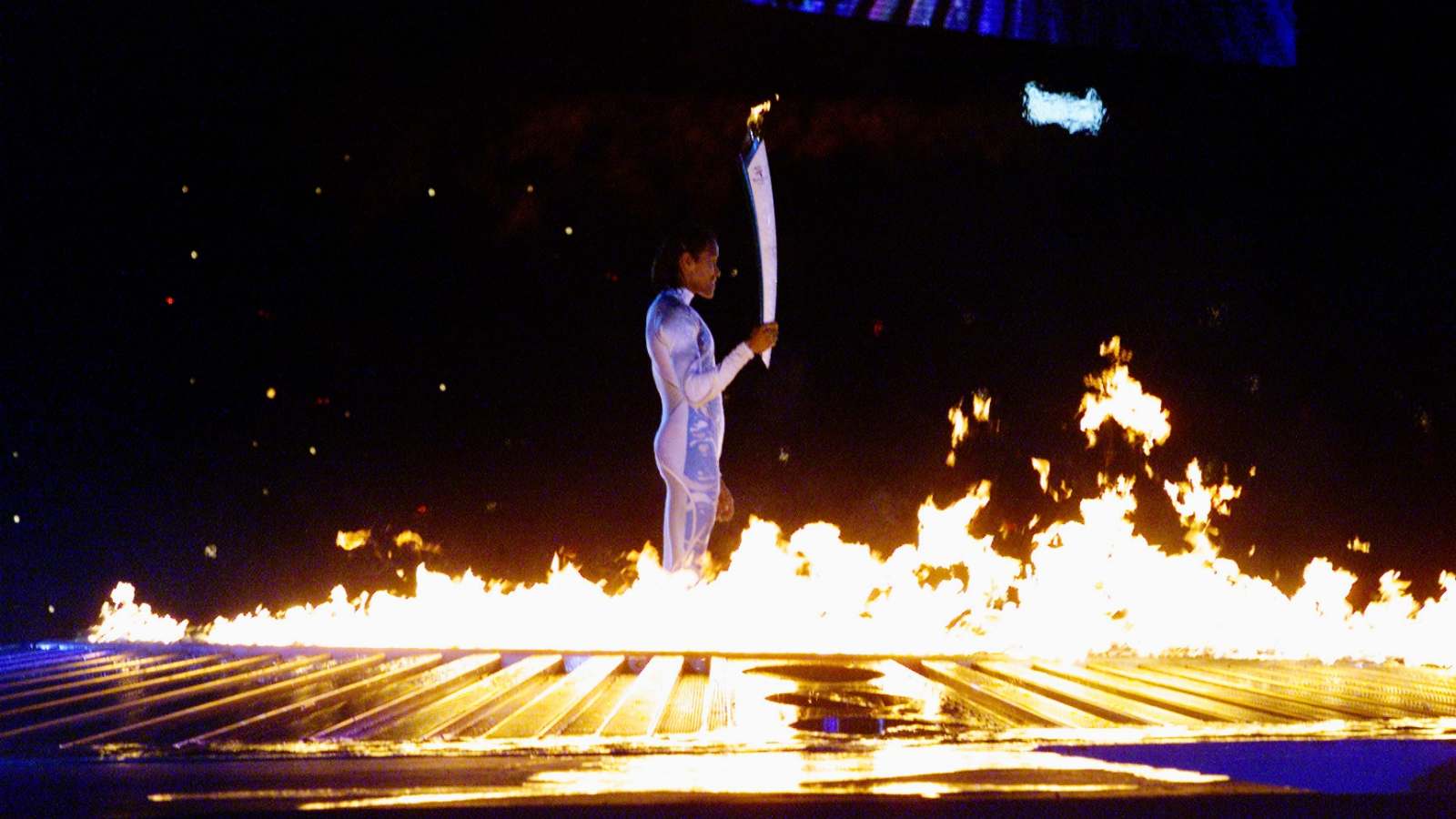From the Archives, 2000: The spectacular opening of the Sydney Olympics
by Corrie Perkins, Alan Attwood and Caroline OveringtonFirst published in The Age on September 16, 2000
It was a show to be proud of, and Australian culture was the star
It was an event made for television. Yet, as we watched enviously from our homes in Warracknabeal, West Wyalong, Glen Iris, Glen Innes and beyond, we wished oh, how we wished we'd been there at Homebush Bay with the 110,000 people lucky enough to be in the audience.

Still, the night was not without its spine-tingling moments. Superb camera work brought us an opening ceremony we will long remember not only because it happened in our own country, but also because it was such a ripper of a show.
You had to switch off when Bruce McAvaney went into his nationalistic preamble, just after 6.30pm. (Someone else wrote the script, remember, so don't take it out on poor Bruce.) And when a reporter door stopped Prime Minister John Howard outside the entrance to Stadium Australia, you could almost hear a collective Australian TV audience groan. "It's certainly marvellous and it's great and I hope the whole country enjoys it tonight," our leader told us in a deadpan voice. Whatever you do, Prime Minister, don't talk it up!
Even Garry Wilkinson's corny running commentary on the dance, music, theatre display could not ruin the riotous fun that was unfolding on the box.
The stadium entrance of the Australian team will live long in our memories. So, too, will the cauldron lighting. But the greater gift opening ceremony organisers gave to Australia was the icon parade. Dozens of typically national experiences and achievements were revealed to a world that, on the whole, knows little about our country.
The excitement of a day at the beach. A little girl applying blockout to her nose. The magnificent marine life of the Great Barrier Reef. Our Aborigines, proud and solemn, dancing a dance thousands of years old.
And then the funny, quirky, typically Aussie icons. Wool bales in cardboard boxes that jumped and jived to the sound of music, which then turned into sheep and then, with one bustout, became men and women pushing Victa mowers. So many synchronised shapes that were probably best viewed via the camera lens.

And wasn't it an odd night to be out in the suburbs. At thousands of gatherings around the country, people ate takeaway on their knees, drank wine and applauded a culture we long thought too varied and too laidback to encapsulate. "I'd like to see a thousand lamingtons parade, in formation, marching to the sounds of Waltzing Matilda," a friend told me yesterday morning. She wasn't far off; no lamingtons, but we had Ned Kellys, corrugated iron and many more familiar images to make us smile.
At 8.30pm, the athletes were still to arrive in the stadium. Every minute towards that moment reminded us that this was a show, seven years in the making and, like all shows, it would soon be over. Once the athletes paraded, it was down to business; this was, after all, a sporting carnival, and that the aim of the next two weeks would be to compete.
For a couple of hours, though, it was showtime. Australian culture was the main star. And what a fabulous opening night she had. Bravo!
First published in The Age on September 16, 2000
Cathy lights the spirit of Australia
What a night. Sydney's night. Australia's night. Cathy Freeman's night. A triumph for women and indigenous Australians and almost a tragedy for technology.
Standing tall before a waterfall, Freeman lit the Olympic cauldron after earlier taking part in the marchpast of Australian athletes. It was a marvellous, poignant moment. But then the seven tonne cauldron, which was meant to rise gracefully up a ramp, shuddered, shook and stopped before, finally, making its way up above the stadium.
So say g'day. Go on. It won't hurt. IOC president Juan Antonio Samaranch managed it. Say bienvenue and hello and welcome. There's no avoiding it. The Olympic experience is upon us. The Games are officially underway.

Last night's loud, long and colourful opening ceremony began with the sound of Aboriginal tapping sticks. It ended with a huge Olympic flag covering all the assembled athletes, fireworks and a flaming cauldron high up over the Olympic stadium.
The end marked a beginning: the start of Sydney's Games. Now the formalities are done with. The athletes, at last, take centre stage.
Australia's second Olympics paid tribute to its first, as well as some of its most famous women. Betty Cuthbert, Dawn Fraser and Shirley Strickland de la Hunty, all gold medal winners in Melbourne 44 years ago, were among a group that brought the Olympic torch near the end of its 100-day journey.
After a trip by river to Homebush Bay, the torch was carried into the stadium by Herb Elliott, running slower than he did in Rome in 1960. Then, in a fitting tribute to the centenary of women's participation in the Olympics, he passed the torch to the relay of final torchbearers, a group that also included a teary Raelene Boyle, pushing Cuthbert in a wheelchair, Shane Gould, Debbie Flintoff-King and then, finally, Freeman.
What had been a cool, grey Sydney day was lit up by an opening ceremony that blended fire and water, old and new Australians, stockmen and women on horseback and deep sea creatures.
There was Dreaming, there was an Awakening. There were Aboriginal dancers and a three-person "Endeavour" bicycle; nods to icons and symbols ranging from Captain Cook to Sidney Nolan's Ned Kelly, the Great Barrier Reef, waratahs and even the suburban lawnmower.
No other Games ceremony has included mowers or paid homage to corrugated iron; no other Games have said, or sung, "G'Day". Nowhere else has a stadium been filled with the fragrance of burning gum leaves.
History was made in all sorts of ways: a tiny team from East Timor, officially marching in as "Individual Olympic Athletes"; a standing ovation for North and South Koreans marching hand-in-hand behind one flag; the biggest Australian team led by basketballer Andrew Gaze. Some 498 members of the 628-strong Australian team entered the stadium to applause and cheering, then tossed small yellow kangaroos into the crowd.
The scale of the show was massive: 12,697 performers; a backstage crew of 4600; a pricetag suggested to be about $5 million; 11,600 athletes and officials representing 200 countries. All, at different times, in a stadium packed with 110,000 spectators and a TV audience reckoned in billions.
They saw no koalas; no more inflatable kangaroos on bikes. But this was an unashamedly dinkum ceremony.
The director of the ceremony, Ric Birch, described the creative segment preceding the parade of athletes as "a highly visual narrative", one that would not rely on commentary to make it explicable to the vast TV audience overseas.
Both he and the show's artistic director and producer, David Atkins, said there were lots of messages, subtle and resonant ones, within the program. Amid all the colour and movement there was an "Awakening" segment, staged by indigenous performers, with a reconciliation theme.
"It had to be a true portrait of Australia," Birch said. "We are a passionate people, creative people."
Birch and Atkins described the ceremony as both an evocation of Australia's past and a reflection of contemporary Australia. "This is a country going through change," said Atkins. "We were trying to give that a creative focus."
But despite the years of planning and all the technical geewhizzery - including 11 cables suspended 45 metres all the way across the 111metre space between grandstands, so that children and sea creatures could become aerialists - the ceremony organisers conceded they were always going to be upstaged by the coming together in the stadium of all the athletes. This, said Birch, is the "emotional highpoint" of any ceremony.
Not quite. That was, as it always is, the lighting of the cauldron. When the host asked question of the past few months, “who would light the cauldron?” finally got an answer.
Poet Dorothy Porter has written some verse especially for these Games. She read it to a crowd outside Sydney's Town Hall on the eve of this opening ceremony. She described Sydney shining, lit up by the Olympic flame. For once, she said, "we welcome fire". And now fire is burning above the Olympic Stadium, unquenchable for a fortnight.
First published in The Age on September 16, 2000
A sea of emotion sweeps Australia into the night
For 16 days they will carry the weight of Australia on their shoulders. But last night was their turn to take the lead. And were we with them?
"Australie," rang out from the public address system and then "Australia", which could barely be heard. The sound that greeted the home team as it marched its outback uniforms onto the home soil at Homebush was not so much thunderous as a lightning bolt.
Stadium Australia cracked with emotional applause when Andrew Gaze's massive frame walked out shortly after 10 o'clock last night. Perhaps it was the purest moment Sydney 2000 will deliver. No pressure to perform, no politics, no race argument and no drug test at the end of it. Just the very best we have serenaded by Livvy and Whispering Jack representing us.
Refusing to rush the biggest moment, Australians sauntered around the stadium hurling golden rubber kangaroos into the screaming crowd of 110,000.
Cathy Freeman was one of the first to throw her joey and it read, like all the others, "Cheer us on Australia".
Most of them waved but some simply held up one finger. "We are number one tonight," they were telling the world.
Only once before have Australian athletes led their team at a home Olympic opening ceremony. But Melbourne in 1956 was a different world to Sydney 2000. There was no satellite TV and no direct overseas broadcast. There was no mobile network or cheap international flights or stadium big screens. The world was a very big place and it was easy to hide.
Not that any Australian sportsman or woman wanted to hide from the microcosm of Australia that last night's Sydney debut presented. Many of the 491 who marched are accustomed to competing in a vacuum arriving at venues unrecognisable to this, forced to explain their way in, compete to little or no applause, shower and go home.
Most will never star on a stage like this again. None will ever hear such cheering. As team director and gold medallist Herb Elliott put it: "More than 100,000 lumps in 100,000 throats greeted Andrew Gaze." And his Australian flag.
Elliott assured the athletes before the march that this would be their biggest stage. And he was happy with the picture they presented. "It's the first time Australia on this scale has showed itself as a sophisticated nation and not a pack of Crocodile Dundees," he said.
Ric Birch, for all his artistic, technical and logistical brilliance, happily handed over the baton to the real stars of the opening. Australia's entrance, said Birch, was "unmistakably the emotional high point".
Although close to 500 athletes represented their country at the Olympic Stadium, 137 did not. There was no Ian Thorpe last night and no Grant Hackett. The cheers for them begin today. Like Australian striker Mark Viduka, world champion cyclist Shane Kelly and our women triathletes all of whom compete on day one it would have been crazy to march.
But they, along with other absent competitors you've never heard of, had other things on their frantic minds last night. Still they have wished all week that they could march. In the end most lay on the lawn of the Olympic Village and watched on a big screen.
"I just hope Australia appreciates the huge sacrifices the athletes have made who are not marching," said Herb Elliott. "It was their choice along with their coaches but it hurt."
Ric Birch had pushed for gold Drizabones that glowed in the dark for the Australian team, but was vetoed by John Coates and the AOC. Still Birch managed to illuminate the Australians with the reflective strips on their courier bags and the Southern Cross stars on their back pockets.
From their hatless heads to their Nike runners (men) and slides (women), the team was said to be overwhelmingly delighted with their "cool" outfits, despite the fact that earlier and very private market research conducted by the AOC and SOCOG indicated that most Australians preferred green and gold to ochre, the rusty Uluru red of the stockmen's coats and women's jackets.
If reputations were made last night and careers in politics, sport, art and technology secured for life, there were other simpler stories which added to the romance. Like that of Wade Bennett, the 28-year-old Olympic volunteer who five years ago lay in a coma, his organs exploded, following a water-skiing accident that also broke almost every bone in his body.
Seven weeks ago Bennett learned he would lead the Australian team onto the arena and carry his nation's banner. Amazing consolation for his lost ambition of making the 2000 triathlon team. He said yesterday he had not slept through a night since late July.
Bennett's peroxide blond head and small frame was dwarfed by team captain Andrew Gaze, the closest thing Australia has to an untarnished sporting hero. Grey-haired and 35 years old, he remains the boy next door of the Olympic team. We are used to Gaze's goofy smile but this was something else. A slam dunk to heaven.
Village mayor Graham Richardson told the Australian team, which four nights ago assembled for the flag-raising ceremony that they need never doubt that all of their country would be behind them.
"You can count on Australians giving you their support," said Richardson. "Because you are what they'd like to be."
Given that most Australians will only ever dream of marching for their country at an Olympic opening ceremony, 110,000 dreamers witnessed the moment at Homebush last night and record millions more saw it live on television.
And for the 491 elite who marched, they did so knowing that their country was behind them like never before. Or again. Australian Olympians have won 86 gold medals over 24 campaigns and remains one of only three nations to have competed every time. The host country believes it can add another 20 gold this time around. Here goes.